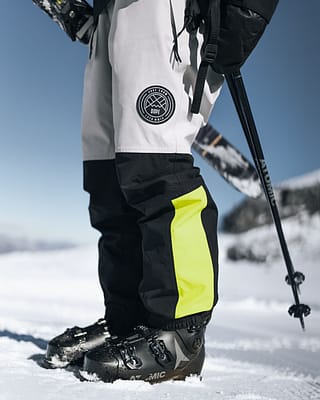What is the right ski pole length for me?
Whether you’re new to skiing or a seasoned pro, it’s always good to get your set up dialled in. Check out our guide to ensure you’ve got the right length ski poles.

If you’re looking to pick up a set of your own, or you just want to know what to look for next time you’re renting your ski gear, this guide on getting the correct length ski poles is going to help you make the right decision. While the old sizing methods still ring true, there are a few things that may change your preferred length. So if you’re curious and ready to learn a little bit more about ski poles, we’ve got everything you need right here.
A well-rounded skiing setup from poles to attire
Navigating snowy peaks with skiing poles is a central part of the adventure, but there's more to consider. The accompanying attire completes the journey, effectively merging functionality with style. Our comprehensive range ensures that you're prepared for every downhill thrill with just the right gear. Explore our collections of both women's ski clothes and men's ski clothing, designed to offer you the peak of comfort, durability, and style, whether you're carving through fresh powder or gliding down groomed runs. Skiing isn't just about the ride; it's about feeling and looking great whilst you do it.
Ski pole sizing
When it comes to sizing, the simplest way is to do it by height. The length can be pretty approximate and still be comfortable. As most humans are similarly proportioned, the length of two people’s upper arms is likely to be pretty similar if they’re the same height.
Because of this, we can confidently say that the below measurements will probably serve you quite well. So check out this table below for a quick and dirty rundown on the right pole length, or read on for a little more information on the nuances of pole sizing.
| Skier Height (cm) | Pole Length (cm) |
| 200 + | 140 |
| 193 - 198 | 135 |
| 184 - 190 | 130 |
| 178 - 183 | 125 |
| 170 - 175 | 120 |
| 163 - 168 | 115 |
| 155 - 160 | 110 |
| 145 - 152 | 105 |
| 135 - 142 | 100 |
| 124 - 132 | 95 |
| 114 - 122 | 90 |
| 104 - 112 | 85 |
| < 101 | 80 |
How to check your ski pole size
The general way that ski poles are size-checked is by turning them upside down. Grab the tip just above the bask and place the handle on the ground. If your elbow is angled at 90-degrees, that’s the right size for general use. This gives you pretty good support, strength, and leverage, without being too unwieldy.
While the above measurements are likely to serve you well, you may wish to size up or down on purpose. The reasons for this are pretty varied depending on your preference, the conditions of the snow, and the type of skiing you’re doing.

When to size up or down
For backcountry skiing or ski touring, you may wish to size up a little, so you can better deal with deeper snow and have better leverage to move through tricky terrain. Also, as the pole sinks into the snow, you’ll have less support, so a longer pole can be helpful. However, they become more awkward to use. However, there’s a way around that, which we’ll discuss in a bit!
Freestyle skiers may wish to size down a little because their poles make them more agile. It also allows for a more ‘relaxed’ position with a lower wrist position than normal. On the other hand, poles are normally used for quick corrections on the approach to features while skiing freestyle, so there’s not a necessity to have long poles that allow for maximum leverage. Though any deviations from the ‘standard’ length aren’t dramatic — usually a few centimetres either way makes the difference!
Telescopic poles
Telescopic poles are becoming more popular, especially for backcountry and touring. They can be extended for extra usefulness in deeper snow and then shortened on the descents. If you get stuck, extending them to their max length is also a useful option! And they can be used to help another skier out of trouble if they fall or sink in some fresh powder. There’s no use for them in the resort, though.

Parts of a ski pole
The ski pole is usually made of four parts; the handle, which is what you hold, the shaft, which is the long part, the basket, which is the small round protrusion above the tip that prevents it from sinking into the snow, and the tip, which digs into the snow. The design hasn’t changed since their creation for the most part. That old saying comes to mind — if it isn’t broke, don’t fix it!
Straps
Some skiers opt to use straps while others don’t. Straps will ensure your ski poles aren’t lost in a fall, which is useful in the resort. However, some skiers riding steep backcountry terrain will forgo straps as in a long tumble, poles can sometimes cause more injury, either by stabbing you or getting caught/trapped and causing torsional damage in the wrists and arms. Straps will likely save you from losing a pole to gravity for any resort skier! But for those who are skiing the backcountry, well, it’s just something to think about!
Materials
However, ski pole material has been an aspect of their design that has evolved. In the beginning, they were made of wood, but now, you’ll likely be choosing between aluminium and carbon fibre. Both have their merits, which we’ll run through quickly below.
Aluminium poles are cheaper and are strong and light. They don’t tend to snap but rather buckle or bend, kinking on impact. They’re also more cost-effective. Carbon fibre poles are light and stiff — more so than aluminium — and are great for racing or touring when a few fewer grams of material make all the difference over a long time. For the most part, however, aluminium poles are great and plenty light for resort and side-country fun.

Do I even need ski poles?
You may have noticed some skiers don’t use poles at all. They aren’t exactly necessary and are mostly used for directional correction while riding. If you don’t feel you use them or don’t like the idea of holding onto them all day, there’s nothing to say you can’t ski without them. I know lots of skiers who prefer riding with their hands-free. It’s all preference!
FAQs
What happens if I choose the wrong size?
Using the wrong pole length might lead to discomfort and inefficiency. Too short poles can make you bend too much and cause muscle strain, while too long poles can feel unwieldy, affect your balance, and increase fall risk.
Are ski pole straps necessary?
The choice to use straps depends on personal preference and terrain. In a resort, straps help ensure your poles aren’t lost in a fall. However, some skiers prefer not to use them in steep backcountry terrain, as poles may cause injury in a long tumble by potentially causing torsional damage to the wrists and arms.
Wrapping up
You may wish to size up or down slightly, but in the end, ski poles should measure between your navel and sternum at the store, and when planted in the snow, still have your arms are around a 90-degree angle. This gives a good balance of power and maneuverability for general use. Size up or down for preference, or ditch them altogether if you like to wave at people as you go by. Hopefully, this guide has been useful. Now have some fun buying your next set of poles!
Related Reading:
